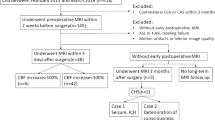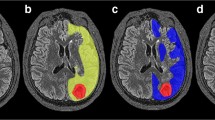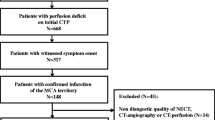Abstract
Introduction
The purpose of this study was to compare the results of perfusion computed tomography (PCT) with those of 15O2/H2 15O positron emission tomography (PET) in a subset of Carotid Occlusion Surgery Study (COSS) patients.
Materials and methods
Six patients enrolled in the COSS underwent a standard-of-care PCT in addition to the 15O2/H2 15O PET study used for selection for extracranial–intracranial bypass surgery. PCT and PET studies were coregistered and then processed separately by different radiologists. Relative measurement of cerebral blood flow (CBF) and oxygen extraction fraction (OEF) were calculated from PET. PCT datasets were processed using different arterial input functions (AIF). Relative PCT and PET CBF values from matching regions of interest were compared using linear regression model to determine the most appropriate arterial input function for PCT. Also, PCT measurements using the most accurate AIF were evaluated for linear regression with respect to relative PET OEF values.
Results
The most accurate PCT relative CBF maps with respect to the gold standard PET CBF were obtained when CBF values for each arterial territory are calculated using a dedicated AIF for each territory (R 2 = 0.796, p < 0.001). PCT mean transit time (MTT) is the parameter that showed the best correlation with the count-based PET OEF ratios (R 2 = 0.590, p < 0.001).
Conclusion
PCT relative CBF compares favorably to PET relative CBF in patients with chronic carotid occlusion when processed using a dedicated AIF for each territory. The PCT MTT parameter correlated best with PET relative OEF.



Similar content being viewed by others
References
Kudo K, Terae S, Katoh C, Oka M, Shiga T, Tamaki N, Miyasaka K (2003) Quantitative cerebral blood flow measurement with dynamic perfusion CT using the vascular-pixel elimination method: comparison with H2(15)O positron emission tomography. AJNR Am J Neuroradiol 24:419–426
Wintermark M, Sesay M, Barbier E, Borbely K, Dillon WP, Eastwood JD, Glenn TC, Grandin CB, Pedraza S, Soustiel JF, Nariai T, Zaharchuk G, Caille JM, Dousset V, Yonas H (2005) Comparative overview of brain perfusion imaging techniques. Stroke 36:e83–e99
Derdeyn CP, Videen TO, Simmons NR, Yundt KD, Fritsch SM, Grubb RL Jr., Powers WJ (1999) Count-based PET method for predicting ischemic stroke in patients with symptomatic carotid arterial occlusion. Radiology 212:499–506
Woods RP, Mazziotta JC, Cherry SR (1993) MRI-PET registration with automated algorithm. J Comput Assist Tomogr 17:536–546
Herscovitch P, Markham J, Raichle ME (1983) Brain blood flow measured with intravenous H2(15)O. I. Theory and error analysis. J Nucl Med 24:782–789
Wintermark M, Maeder P, Thiran JP, Schnyder P, Meuli R (2001) Quantitative assessment of regional cerebral blood flows by perfusion CT studies at low injection rates: a critical review of the underlying theoretical models. Eur Radiol 11:1220–1230
Axel L (1983) Tissue mean transit time from dynamic computed tomography by a simple deconvolution technique. Invest Radiol 18:94–99
Ladurner G, Zilkha E, Iliff D, du Boulay GH, Marshall J (1976) Measurement of regional cerebral blood volume by computerized axial tomography. J Neurol Neurosurg Psychiatry 39:152–158
Wintermark M, Lau B, Chien J, Arora S. Anterior cerebral artery is an appropriate arterial input function for perfusion-ct processing in acute stroke patients. Neuroradiology (in press)
Ostergaard L, Weisskoff RM, Chesler DA, Gyldensted C, Rosen BR (1996) High resolution measurement of cerebral blood flow using intravascular tracer bolus passages. Part I: Mathematical approach and statistical analysis. Magn Reson Med 36:715–725
Wu O, Ostergaard L, Weisskoff RM, Benner T, Rosen BR, Sorensen AG (2003) Tracer arrival timing-insensitive technique for estimating flow in MR perfusion-weighted imaging using singular value decomposition with a block-circulant deconvolution matrix. Magn Reson Med 50:164–174
Calamante F, Gadian DG, Connelly A (2000) Delay and dispersion effects in dynamic susceptibility contrast MRI: simulations using singular value decomposition. Magn Reson Med 44:466–473
Knutsson L, Larsson EM, Thilmann O, Stahlberg F, Wirestam R (2006) Calculation of cerebral perfusion parameters using regional arterial input functions identified by factor analysis. J Magn Reson Imaging 23:444–453
Gibbs JM, Wise RJ, Leenders KL, Jones T (1984) Evaluation of cerebral perfusion reserve in patients with carotid-artery occlusion. Lancet 1:310–314
Schumann P, Touzani O, Young AR, Morello R, Baron JC, MacKenzie ET (1998) Evaluation of the ratio of cerebral blood flow to cerebral blood volume as an index of local cerebral perfusion pressure. Brain 121(Pt 7):1369–1379
Powers WJ (1991) Cerebral hemodynamics in ischemic cerebrovascular disease. Ann Neurol 29:231–240
Hemphill JC III, Smith WS, Sonne DC, Morabito D, Manley GT (2005) Relationship between brain tissue oxygen tension and CT perfusion: feasibility and initial results. AJNR Am J Neuroradiol 26:1095–1100
Acknowledgment
This research was supported by USPHS grant NS42167 (William J. Powers, Principal Investigator).
Conflict of interest statement
We declare that we have no conflict of interest.
Author information
Authors and Affiliations
Corresponding author
Rights and permissions
About this article
Cite this article
Kamath, A., Smith, W.S., Powers, W.J. et al. Perfusion CT compared to H2 15O/O15O PET in patients with chronic cervical carotid artery occlusion. Neuroradiology 50, 745–751 (2008). https://doi.org/10.1007/s00234-008-0403-9
Received:
Accepted:
Published:
Issue Date:
DOI: https://doi.org/10.1007/s00234-008-0403-9




